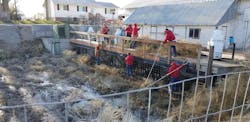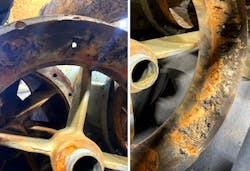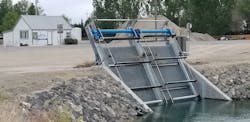Bar Screen Clears the Tumbleweeds
Brent E. Crowther, P.E., PMP, CFM, is president of Civilize, PLLC Management & Eng. Crowther can be reached by contacting Beth Boeh at beth.boeh@
In Eastern Idaho, tumbleweeds and other debris have plagued the cooperative Mud Lake Water Users (MLWU) Inc. for years. This canal company is responsible for delivering water for irrigation to farmers in the region.
The debris captured by its decades-old stationary screen was labor-intensive to clear by hand multiple times per day during irrigation season. It needed to find a better way to protect the pumps in the adjacent pumping station, which were at risk of interrupting the necessary 160,000 gallon-per-minute capacity.
An automated screening system installed in 2019 requires almost no maintenance, has secured the safety of its workers, is effectively protecting the expensive pumps, and allows MLWU Watermaster Shaun Grover to spend his time distributing water for crops instead of manually cleaning screens.
A Canal Clustered With Organic Debris
Mud Lake Water Users Inc. is a non-profit irrigation company formed in March of 1998 from the Owsley Canal, Jackett Canal and Holley Water Users. The company owns water rights for irrigation storage in Mud Lake, a natural closed basin in Eastern Idaho that is fed from the nearby Camas and Beaver Creek drainages and by artesian and pumped wells.
Mud Lake is used as a reservoir for storage of irrigation water before the water travels through a series of supply canals, two major pump stations that lift water into the Owsley Canal and multiple minor canals and ditches that convey the water to 130 farms. Farmers use the delivered water from the canals to flood irrigate and pump the water into pressurized sprinkler systems for irrigation of crops, primarily alfalfa, potatoes, wheat, and silage corn.
The canal is empty during winter, but during spring when the Owsley Canal is filled with water from Mud Lake for irrigation, the eastern Idaho terrain is so flat and windy that the lake and canal are overrun with tumbleweeds, willows, cattails, and cottonwood limbs and branches. And in late summer, after months of long days and sunshine, algae and moss form in the canal. Screening, therefore, is crucial to the operations of the MLWU. Without effective screening, the four 42-inch-diameter, 200-hp pumps at the nearby Owsley Pumping Station would be in jeopardy. If debris gets through the screen and into the propellers, it can destroy the pumps or cause lost production time if pumps need to be shut down.
During the irrigation season, from May 1st to October 31st, it is imperative that the water travels consistently to the crops. With each pump producing about 45,000 gallons per minute, there is no time for shutdown. Grover’s main concern was the pumps.
“When you drop the water level on a turbine pump, the air is more damaging than actual sand and dirt; it acts like dynamite, pitting and destroying the impellers and suction ring,” Grover said. “By dropping the water level because of debris, you’re putting premature wear and tear on the impellers and suction ring, damaging equipment and losing pumping efficiency. Then there’s the cost and time to replace the equipment. You can’t just go to the store to buy a nearly four-foot pump. If I lost just one of my pumps, it would cost around $200,000 to replace…plus we would be down six months while we waited for a special-order pump to be built. That just can’t happen.”
Not-so-Standard Screen
A two-part screen constructed 50 years ago was the only protection for the pumps, similar to bar screen's use in a primary wastewater treatment application. A metal screen with a 1.5-inch opening caught underwater debris while another screen made of wooden two-by-fours spaced 1-inch apart caught the overflow on top of the water. To clean out the debris and protect the pumps, MLWU would hire people, often local high school students, to clean the old screens using pitchforks to toss the debris over the railing and onto the deck while standing on a platform that was less than three feet wide.
Worker safety was a major concern since they were directly upstream of the adjacent pumping station. If a worker were to fall into the water, the pumps would need to be shut down immediately to prevent the workers from being sucked into the propellers. Shutting down the pumps causes moss to backflow and the canal level can drop.
Bottom line: pumping efficiency is lost, and it can take hours, even up to an entire day to catch up. In addition to needing to protect the pumps, MLWU was concerned about the risk to the workers being above a canal filled with 6 to 8 feet of water with 480-volt power. Thankfully there had never been an incident, but the non-profit did not want to continue to put its crew in jeopardy.
The process of manually clearing the old, dilapidated screen every few hours was labor intensive, expensive, and potentially dangerous. MLWU was concerned for the safety of its workers as well as the ongoing operations and maintenance of the screening system, and began to consider other ways to screen the debris.
Moving Toward Automated Bar Screens
In 2016, MLWU hired Civilize, PLLC Management and Engineering to conduct a feasibility study for upgrading its existing manual screening system to an automated technology.
While it was evident from the study that automating the process would have long-term financial benefits, the initial capital investment was a concern to some of the board members. Having done it himself hundreds of times over 20 years, Grover knew the cleaning process was extremely labor-intensive. He was always in favor of automation, knowing that efficiency issues could delay his farmers from receiving the water they needed for their crops.
Insufficient water to irrigate the crops could result in an estimated 40% loss of the crop and tens of thousands of dollars depending on the weather, the type of crop, and the stage of the crop. The money invested in automated screens would effectively guarantee adequate water for the duration of the summer.
In 2017, the opportunity to address the screening issues presented itself when the Idaho Transportation Department required a bridge removal project upstream of the Owsley Pumping Station. Because the new culvert crossing would be much narrower than the existing bridge, MLWU would need to add a new bar screen in front of the new channel so it would not jam with debris. Still reluctant to invest in an automated bar screen, MLWU had a 2-inch opening static steel screen installed in 2018.
The new static screen was in place for just one year. However, it did not improve the maintenance issues, but rather made them worse. Because MLWU kept the original metal and wooden screen adjacent to the pumping station to function as a secondary screen, it now needed to manually clean two screens multiple times each day. The board agreed it was time to make the investment into automation after recognizing the increased stress this caused.
Automation is the Answer
The MLWU board reviewed a couple of different automated screen manufacturers and Duperon stood out because of the longevity of both its equipment in the field and the company itself.
If it were going to make a significant investment into automation, the board wanted to feel sure it was getting the best value for the money and the Duperon warranty also gave board members the peace of mind needed to proceed.
One of the features important to Grover and to MLWU Board President Steve Shively was the front-clean, front-return design that the Duperon team had invented 35 years ago. This ensures all moving parts of the bar screen are accessible above the water line, meaning there would be no lower sprockets, bearings, tracks or guides that would require underwater access. The minimal maintenance required could all be performed from the deck. Another factor in the decision was that the Duperon FlexRake was also easy to integrate into the existing SCADA program.
Brent “Husk” Crowther from Civilize PLLC specified the equipment. He had worked with Duperon automated bar screens for wastewater applications and was pleased with the results. He felt it would offer the right solution to solve the Mud Lake Water Users’ problems.
Installing the Bar Screen Solution
In 2019, two FlexRake FRHD bar screens—prefabricated in Saginaw, Michigan in Duperon's manufacturing plant—were installed at the 10-foot wide, 16.5-foot deep channel in the Owsley Canal, about 1.5 miles south of Mud Lake at the entrance to the new culvert. The primary Duperon screening system includes two screens set at a 30-degree angle with a 2-inch opening with a combined flow capacity rated 161.58 million gallons per day.
The bar screen provides continuous cleaning and is designed for applications where debris size, velocity, and flow are unpredictable. The FlexLink multifunctional link system with 5-pound stainless steel cast links and a strength of 60,000 pounds provides a durable system that can work effectively for decades.
The bar screen also has Duperon's Jam Evasion technology, which allows the multifunctional link system to lift and pivot around debris, allowing the automated screening system to adapt to a wide range of debris variations with up to 1,000 pounds of lifting capacity. One hundred sixty-five feet downstream of the new bar screening system, the original 1.5-inch metal screen adjacent to the Owsley Pumping Station was left in place as a secondary screen to catch any additional debris that might blow into the canal after (or behind) the new screen.
The installation also was unusual because the bar screen was installed with water already in the canal. Assembled in advance, the screens were lifted by the crane separately and mounted to the bottom of the canal at a pre-anchored footing plate and bolted to the top head wall. A few expected adjustments were made in real time so the screen could fit perfectly in the space, and the installation took just a few days. There were no issues.
Duperon developed the new screening system specifically for these types of applications, so the technology was designed to handle whatever ends up in an open channel.
Bar Screening Automation Labor Savings
The automated screening system has been running for nearly two years now. Today, instead of cleaning the screens every few hours each day, MLWU clears the debris from the smaller secondary screen about once per week.
Workers estimate that the difference between the old way—including labor and backhoe—is $12,324 per year, a 53% savings in labor costs. Power costs for the new automated screen is negligible with the energy-efficient 0.5-horsepower motor of the Sumitomo drive system.
But it is not just cost savings that has made this project such a success. Grover's daily routine used to be to get up in the morning, check the screening system first thing, then spend two hours each morning clearing out the screens manually. Then, depending on the day and the flows, he might have to come back again, up to two more times to clean the screens again.
The new equipment has freed up his days, allowing him to focus on his first priority as watermaster: delivering the water to the farmers quickly. Now he also has more time to address the other concerns of his stockholders, including maintenance and repairs on the canal, tending to the 35 deep wells that provide water for Mud Lake when snow runoff is insufficient, working on SCADA programming, monitoring the entire network, and generally running the business of the MLWU. In fact, since the Grover lives on site and is on-call 24 hours a day for six months of the year, he now even has time to spend with his wife and children.
“I highly recommend the system because it has significantly reduced our manual labor needs and safety concerns," Grover said. "We’ve increased our pumping efficiency and have consistent flows and, most importantly, I know my employees aren’t at risk. The new Duperon automated screens cost roughly the same as one pump. That’s been well worth it for us to know the pumps are protected. And we can now spend our time distributing water to the farmers instead of cleaning screens.”



